Exploring the Life and Legacy of Triceratops

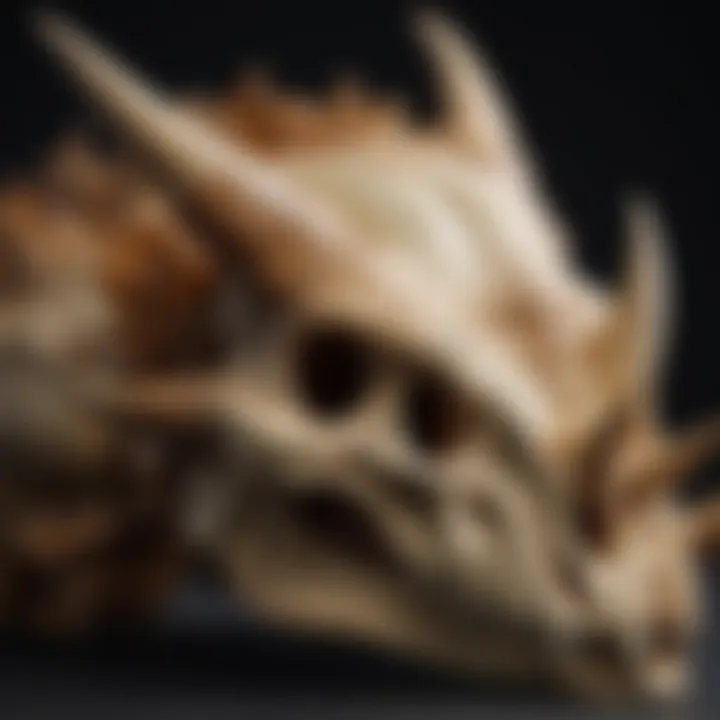
Intro
The Triceratops, a name that conjures images of vast landscapes dotted with awe-inspiring creatures, has long captured the imagination of both paleontologists and the public alike. This iconic dinosaur roamed the Earth approximately 68 to 66 million years ago during the late Cretaceous period. The sheer size of Triceratops, paired with its distinctive three-horned face and a massive bony frill, make it not just a spectacle of nature but also a vital piece in the puzzle of Earth’s prehistoric history.
As we embark on this exploration, we delve into various facets of Triceratops—from its peculiar anatomy and diverse habitats to its interactions with other species and the significance it holds in both science and culture. With each unearthed fossil, researchers come closer to understanding the life of this remarkable dinosaur, shedding light on its ecological role and the environmental dynamics of its era.
Through a detailed examination, this article hopes to engage the reader and draw attention to the enduring legacy of the Triceratops, connecting the dots from ancient ecological systems to the modern cultural representations that keep its spirit alive.
History and Origins
Overview of Fossils and Finds
Triceratops remains have been found primarily in what is now North America, particularly in the Great Plains region. The first Triceratops fossil was unearthed in the late 19th century, around 1887, by American fossil hunter John Bell Hatcher in Montana. This discovery opened the floodgates for a plethora of fossil finds associated with this dinosaur. Several key sites have yielded well-preserved skeletons, offering insights into its anatomy and life.
In terms of collectibles, Triceratops fossils are among the most sought after. Many rock and fossil collectors dream of owning a piece of its history, be it bone fragments, teeth, or complete skulls. The thrill of discovery connects individuals to a time long past, making each fossil a tangible link to prehistoric life.
Historical Significance and Cultural Impact
The significance of Triceratops extends far beyond the realms of paleontology. Its robust figure has inspired countless pieces of art, literature, and even film, becoming synonymous with the term "dinosaur" itself. Notably, it features prominently in the imagination of children, launching a love for dinosaurs that often lasts a lifetime.
Culturally, Triceratops has become a symbol of prehistoric wonder, appearing in countless documentaries, museum exhibits, and educational programs. Social media platforms, such as Reddit and Facebook, provide forums for enthusiasts to share findings and discuss their passion for this unique creature, showcasing its enduring legacy. As fossil collectors discuss their latest finds, they contribute to a collective history, preserving not just the physical attributes of Triceratops but also its place in human consciousness.
"Every new skeleton found is a glimpse into the past, a whisper of a world where oddities like Triceratops walked the Earth, reminding us of nature’s creativity and persistence."
Identification and Classification
Guide to Identifying Rocks and Fossils
When looking at fossils, especially those belonging to Triceratops, collectors should consider a few key identifiers:
- Texture and Color: Genuine fossils often exhibit a unique texture and may vary in colors based on mineralization.
- Shape: Familiarity with the classic Triceratops shape can help in identification. Keep an eye out for the distinctive three horns and frill.
- Location of Find: Knowing common sites where Triceratops fossils have been located can enhance the chances of finding authentic pieces.
Common Types and Variations
Triceratops is often classified into multiple species based on unique features. The most recognized among these are:
- Triceratops horridus: The classic three-horned giant known for its robust frill and bone structure.
- Triceratops prorsus: Slightly smaller, showcasing variations in skull shape and size.
- Triceratops alticornis: Often characterized by its more pronounced crest, this type adds to the diversity of this magnificent dinosaur.
Understanding these variations not only aids collectors in identifying their finds but also enriches their appreciation of Triceratops as an evolutionary marvel. As research advances, the narrative of the Triceratops continues to evolve, revealing the intricate tapestry of life that once flourished in a world vastly different from ours.
Prelude to Triceratops
When it comes to dinosaurs, few names resonate as firmly as Triceratops. This remarkable herbivore not only captures the imagination with its iconic three-horned face and large frill but also tells a larger story about life on Earth during the late Cretaceous period. Understanding Triceratops isn't merely about recognizing its place in popular culture or its striking appearance; it's crucial for comprehending the dynamics of ancient ecosystems, evolutionary biology, and even paleontological practices. This introduction serves as a springboard into the rich narrative that surrounds this prehistoric giant, setting the stage for a deeper analysis of its anatomy, behavioral patterns, and the ecological niche it occupied.
Overview of Triceratops
Triceratops, belonging to the Ceratopsidae family, appeared around 68 to 66 million years ago during the late Cretaceous. It is characterized by a large bony frill, three distinct facial horns, and a robust body structure, reaching lengths of up to 30 feet and weighing between 5 to 10 tons. These physical traits were not purely ornamental; they likely played essential roles in mating displays, species recognition, and defense against predators, most notably the terrifying Tyrannosaurus rex.
Triceratops thrived within rich, diverse environments, closely associated with a variety of contemporary flora, including ferns, cycads, and flowering plants. Its diet primarily consisted of tough vegetation, which it could efficiently shear with its unique beak. Paleontologists have also gleaned insights into its daily activities, suggesting that Triceratops was a social creature and might have lived in herds for safety against predators.
Historical Context
Triceratops isn’t just another dinosaur; its discovery has fundamentally shaped our understanding of prehistoric life. The first fossils were unearthed in North America in the late 19th century, when large-scale fossil hunting began. This period was not just about the dinosaurs; it coincided with a growing interest in paleontology. The fossilized remains of Triceratops became a pivotal piece of evidence that helped scientists understand the diverse range of life forms and their interactions during the Cretaceous.
During the late 1800s and into the early 1900s, as paleontologists began to classify different dinosaur species, Triceratops emerged as an emblem of this era. Its image has since clung to popular culture, appearing in everything from children's toys to blockbuster films, suggesting an undying fascination with this ancient creature.
In summary, the importance of exploring Triceratops goes far beyond its impressive physical features. The insights gained from its fossils, combined with the historical journey of paleontology, present a compelling case for why this dinosaur remains a symbol of scientific discovery and cultural engagement.
Physical Characteristics
Understanding the physical characteristics of the Triceratops is vital for gaining insight into its life and ecological role during the Late Cretaceous period. These features not only set Triceratops apart from other dinosaurs, but they also played a significant role in its survival and interactions within its habitat. The following sections will focus on distinctive features of Triceratops, drawing out details about its frill and horns, size and weight, and body structure.
Distinctive Features
Frill and Horns
The frill and horns of the Triceratops are perhaps its most iconic traits. This large bony plate at the back of its head, along with the three distinctive facial horns, contributed to both defense and social interaction among its peers. The frill acted as a protective barrier against predators while also serving as a display feature during mating rituals or social dominance contests.
One unique aspect of the frill is the variety in shape and size seen among different Triceratops specimens, indicating possible sexual dimorphism or the impact of environmental factors. Although it may seem advantageous, this variation can complicate fossil identification for paleontologists, presenting a challenge in determining species lineage and relationships.
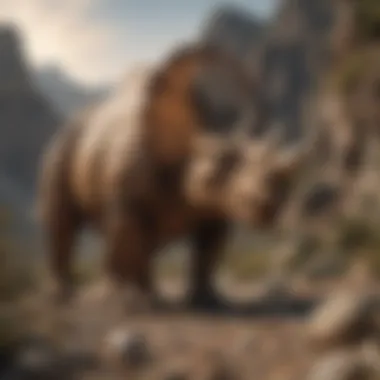

Size and Weight
When you delve into the size and weight of the Triceratops, it’s clear that these dinosaurs were quite formidable. Ranging up to 30 feet in length and weighing as much as 12 tons, the sheer size of Triceratops made it a remarkable creature of its time. This size not only served as a protective mechanism against predators, but it likely influenced its feeding strategies as well. Being so large allowed it to reach vegetation that smaller herbivores couldn't access.
However, such bulkiness came with its own set of disadvantages. For instance, their massive weight could make them vulnerable during certain activities, like quick escapes from threats, potentially impacting their survival strategies in a predatory environment.
Body Structure
The body structure of the Triceratops is fascinating as it showcases a robust build. With a large, barrel-shaped body and sturdy limbs, the dinosaur was well-adapted to its environment. Its stance provided a solid foundation for movement and stability, essential for an animal of its size. Additionally, their powerful legs indicate that they could maneuver effectively across different terrains, from lush forests to plains.
A standout feature of its body structure is the arrangement of its bones, which allowed for a mixture of strength and mobility. While this combination might seem beneficial, it also brought challenges – their relatively short limbs meant that they had limitations in speed, which could alter how they interacted with predators and peers.
Comparative Anatomy
In looking at Triceratops from a comparative anatomy perspective, it becomes enlightening to assess its relation to other ceratopsids, as well as the evolution of its features.
Relation to Other Ceratopsids
Triceratops is often studied in relation to its ceratopsid cousins, such as Styracosaurus and Pachyrhinosaurus. These animals exhibit shared characteristics like frilled heads and similar body shapes, yet Triceratops’ distinctive three horns and broad frill set it apart. This comparative analysis not only highlights the evolutionary diversity within this family but also helps in tracing the origins of its unique features.
The relationships painted through fossil records communicate a rich evolutionary history – revealing both lineage and adaptations over time. An advantage in studying these connections is it illuminates the transitionary phases within similar species. However, disadvantages occur in the form of misidentification and confusion in distinguishing similar species through incomplete fossil records.
Evolution of Features
The evolution of features in Triceratops showcases remarkable adaptations required for survival in its environment. Through various stages of evolution, Triceratops developed its iconic horns and frill likely as responses to predation pressures and environmental changes. The presence of these features alerts us to the ecological dynamics of its time – indicating a battle against predators like Tyrannosaurus rex and providing insight into competition with other herbivores.
One key characteristic of this evolutionary journey relates to how certain traits become emphasized—or diminished—over time based on survival needs, social interactions, and adaptation strategies. Importantly, this examination allows us to postulate reasons behind the gradual modification of these traits. While beneficial to the study of evolutionary biology, this process can reveal gaps in the fossil record, leading to uncertainties in our full understanding of how these grand creatures thrived in their world.
Habitat and Distribution
Understanding the habitat and distribution of Triceratops provides key insights into its lifestyle and survival strategies during the Late Cretaceous. This section examines the ecosystems in which these remarkable creatures thrived, offering a glimpse into their daily lives and the challenges they faced. A thorough appreciation of their environment enhances the knowledge surrounding their ecological interactions and evolutionary adaptations.
Late Cretaceous Environment
Geological Settings
The geological settings of the Late Cretaceous were characterized by a diverse array of landforms shaped by ancient seas, volcanic activity, and tectonic movements. This period saw the formation of thick, sedimentary layers across North America, which became rich in fossils. Such geological features made it a treasure trove for paleontologists seeking to piece together the prehistoric world.
The North American continent was divided between land that was covered in lush vegetation and expansive floodplains, with many areas dotted with rivers and wetlands. This rich geological tapestry contributed to a robust ecosystem that could sustain large herbivores like Triceratops. The lush flora provided a variety of leaves and plants that were crucial for their dietary needs, creating a perfect habitat for this dinosaur to flourish.
Additionally, the unique deposits found in these regions helped scientists better understand the conditions of the time. Some areas, known for being fossil hotspots, revealed well-preserved specimens of Triceratops and other contemporaneous creatures. The abundance of fossil evidence in these geological settings proves invaluable for comprehending the anatomy and behavior of these dinosaurs.
Climate Factors
Climate during the Late Cretaceous was generally warm, with varying local conditions supporting diverse ecosystems. Seasonal shifts likely occurred, which would have affected everything from vegetation types to water availability. This warmth enabled a rich and varied plant life, essential for the herbivorous muse of the late Cretaceous period.
The climate contributed to a relatively stable environment, minimizing radical changes that could disrupt the terrestrial ecosystem. A key feature of this climate was its humidity, which created conditions favorable for lush overgrowth that Triceratops would have flourished in. The abundant vegetation, along with rivers and estuarine systems, offered a reliable food source that was crucial for their growth and reproduction.
However, climate also posed challenges. Periodic changes could lead to fluctuations in resource availability. If a drought occurred, it could severely impact the habitat. Understanding these climate factors adds depth to the study of Triceratops's ecological dynamics.
Geographical Range
North American Fossil Locations
North America serves as the primary geographical range for Triceratops fossils, with some locations becoming iconic among paleontologists. Fossil sites in Montana, South Dakota, and Wyoming have revealed an extensive trove of Triceratops specimens, helping to define the species and understand its adaptability.
The concentration of fossils in these areas illustrates how Triceratops likely migrated in search of resources—either for seasonal feeding or to find mates. The outstanding fossil record from these regions allows scientists to draw significant connections, making them critical for understanding the adaptations of this dinosaur.
The distinctiveness of the North American fossil locations lies not just in the quantity, but in the quality of specimens unearthed. Many fossils exhibit exceptional preservation and detail, offering unparalleled insight into their biology and behavior.
Implications of Distribution
The geographical distribution of Triceratops shares significant implications for our understanding of its behavior and ecological role. Triceratops fossils scattered across North America suggest it was well-adapted to a variety of habitats, indicating its ability to thrive in differing environmental conditions.
This distribution hints at potential social structures and migratory patterns. Larger groups might have inhabited resource-rich areas during certain seasons, creating community dynamics that influenced their behavior. Such patterns also help scientists theorize about the influence of environmental pressures on their evolution.
The wide range of locations where fossils are found highlights the importance of various environments, showcasing the species' adaptability. It is this adaptability that has allowed Triceratops to be a focal point of study in both paleontology and evolutionary biology.
Behavior and Ecology
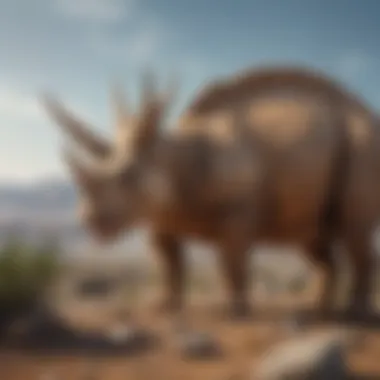
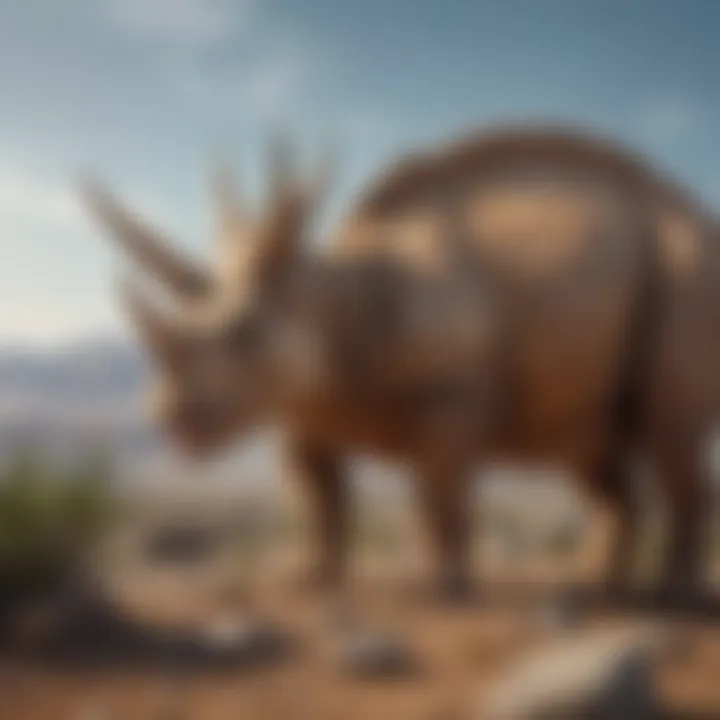
Understanding the behavior and ecology of the Triceratops is essential to painting a complete picture of its life in the late Cretaceous period. This aspect can reveal much about how it adapted to its environment, interacted with contemporaneous species, and secured its survival amidst various challenges. Those details about Triceratops hold the key to grasping its role within the prehistoric ecosystem and underscore the importance of effective group tactics for foraging and defense against predators.
Feeding Habits
Dietary Preferences
Triceratops primarily thrived as a herbivore and its dietary preferences significantly influenced its ecological niche. This dinosaur favored a range of plant species, showing a strong proclivity towards low-lying vegetation such as ferns and cycads. A key characteristic of its diet is the ability of Triceratops to process tough, fibrous plant material effectively due to its specialized teeth structure. This trait was advantageous for digesting coarse plant matter, giving it an edge over other herbivores that might struggle with tougher foliage.
Moreover, being a large herbivore, Triceratops had considerable access to food sources that other smaller dinosaurs could not reach. Its ability to eat a variety of plants provided flexibility and resilience in a dynamically changing ecosystem. However, this dietary diversity also meant it had to contend with competition from other herbivorous dinosaurs, which could sometimes lead to food shortages in densely populated areas.
Interaction with Flora
The interaction of Triceratops with flora was multifaceted. Not only did this dinosaur shape the plant life around it, but it also depended on specific vegetation for nutrition. This relationship is characterized by co-evolution—the flora evolved defenses, while Triceratops adapted to exploit new food sources. For instance, certain plants developed tougher skins or spines to deter this robust herbivore, resulting in a constant evolutionary tug-of-war.
Triceratops contributed to the ecosystem by aiding in seed dispersal through its feeding habits. The unique feature of its grazing style meant that it could access various plant types, thus promoting biodiversity within its habitat. However, the downside is that, similar to other large plant-eaters, it could overgraze in certain areas, which could lead to habitat degradation if populations became too dense.
Social Behavior
Group Dynamics
Triceratops likely exhibited complex social behavior, which is reflected in their group dynamics. Evidence suggests that these dinosaurs may have traveled in herds, providing them with protection against predators and enhancing their foraging efficiency. A notable aspect of their social structure might involve family groups or kinships, which could facilitate cooperative defense and communication—a beneficial tactic in their harsh environment.
The group dynamic is salient because it suggests that Triceratops had social interactions that led to learned behaviors and communal strategies for survival. However, being in a group also meant being subject to social hierarchies, with larger or older individuals possibly leading the herd. This organization not only gave a measure of protection but also helped guide younger Triceratops in navigating their environment.
Territoriality and Defense
The concept of territoriality among Triceratops is intriguing yet complex. While not strictly territorial like some carnivores, these dinosaurs likely maintained a home range where food was abundant. This practice could help mitigate fights over resources within their own population and foster a sense of security within groups.
Defensive mechanisms of Triceratops, notably its formidable frills and horns, indicate a reactive approach to potential threats. These features were not just for show; they allowed Triceratops to fend off predators, contributing to its survival over millions of years. Such adaptations underscore the benefits of evolutionary design, where natural selection favors traits that enhance a species' chances of survival against predators. However, reliance on physical defense may increase vulnerability to challenges such as habitat loss, altering social structures and survival strategies in contemporary discussions about the future of Triceratops's descendants.
"The understanding of Triceratops's behavior and ecology strengthens the appreciation of how this dinosaur not only survived but thrived in a competitive ecosystem. As one of the last ceratopsids, its legacy reflects a complex interplay of adaptation and social structure in an ever-evolving world."
Understanding these behaviors equips the rock and fossil collector community with deeper insights into the life and times of Triceratops, beyond just the physical characteristics captured in fossils.
Paleontological Significance
Paleontological significance of Triceratops extends beyond mere bones and fossils; it unravels a tale steeped in rich history and evolutionary narrative. This iconic dinosaur serves as a cornerstone in understanding the late Cretaceous period’s ecology. It supports myriad research avenues, offering insights into prehistoric life, interactions with the environment, and even climate dynamics affecting species.
The fossils of Triceratops unlock clues into its behavior, diet, and social structures. Every fossil found can provide an essential piece of the puzzle to scientists, enabling them to paint a more accurate picture of what life was like during that era. Moreover, the sheer number of Triceratops specimens discovered speaks volumes about its success and adaptability.
In researching this dinosaur, paleontologists not only explore Triceratops’s traits but also delve into its role in the ecosystem, shedding light on predator-prey relationships and the dynamics of herbivorous dinosaurs in their natural habitat. Triceratops stands at the intersection of evolution, serving as a reference point for studying the development of ceratopsids.
This dinosaur has become a symbol among paleontologists, a golden key to unlock the mysteries of the past and appreciate the diversity of life forms that once roamed the Earth.
Fossil Discoveries
Major Fossil Sites
Major fossil sites housing Triceratops remains offer invaluable contributions to understanding this dinosaur. The Hell Creek Formation in Montana stands out as one of the most significant locations for Triceratops fossils. This site has yielded numerous skeletons, showcasing a variety of specimens spanning different ages and developmental stages, which is crucial for understanding growth patterns. The beauty of Hell Creek lies not just in quantity but also in quality; many fossils found here are remarkably preserved, which allows for detailed analysis.
Collectively, the major fossil sites create a narrative of the Triceratops’s adaptations and interactions with its environment. This area's geology—a mix of sedimentary rocks and ancient river systems—paints a detailed picture of the climate during the late Cretaceous, thereby enriching the story told by each skeleton buried in its sands.
Key Discoveries
Key discoveries concerning Triceratops shine a spotlight on its evolutionary history and ecological role. One remarkable find came from the South Dakota site known as the , which unveiled a nearly complete Triceratops skeleton. What’s especially noteworthy about this discovery is the presence of multiple individuals clustered together, suggesting possible social behavior. Such findings indicate Triceratops likely exhibited a group dynamic, offering crucial insights into their social lives and interactions with other dinosaurs.
These discoveries, while localized, form a broader understanding of Triceratops's ecological niche. They highlight the structural diversity present within ceratopsids and enrich the overarching narrative of dinosaur behavior and interactions. The implications of these finds are profound, allowing scientists to re-examine theories regarding migration patterns and social gatherings among large herbivores.
Research Advances
Techniques in Paleontology
Techniques in paleontology have evolved dramatically, significantly enhancing our understanding of Triceratops. Traditional excavation methods combined with modern imaging techniques—like CT scanning and 3D modeling—allow for deeper insights into the bone structure and conservation of fossils. These methods can reveal hidden details beyond the physical remains. For instance, researchers utilize isotopic analysis to infer dietary habits by examining tiny chemical signatures trapped in tooth enamel, leading to discoveries about what Triceratops grazed on during its lifetime.
The benefits of these techniques are twofold: not only do they preserve artifacts for future study, but they also foster a richer understanding of Triceratops's adaptation strategies, illuminating its place within the ecosystems of the late Cretaceous period.
Insights from Recent Studies
Recent studies focused on Triceratops have made headway in understanding its biomechanics and behavior. For example, research indicates that its unique skull structure was not merely for defense against predators, but also played a crucial role in mating displays and social signaling. Such studies highlight the intricate tapestry woven into its survival strategy.
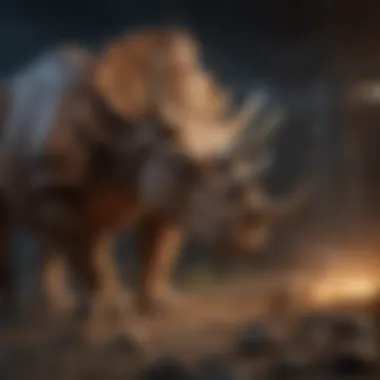

By recognizing these behavioral traits, scientists can better appreciate the complexity of Triceratops's life and its interactions in prehistoric ecosystems. The unique features emerging from these recent insights inspire further research, prompting debates about cognitive abilities and social structures among dinosaurs.
In summary, the paleontological significance of Triceratops is profound. Through fossil discoveries and research advances, it provides a window into the distant past. Understanding this emblematic dinosaur not only enriches our knowledge of itself but enhances our appreciation for the entire Cretaceous ecosystem.
Cultural Impact
The discussion surrounding the Triceratops transcends mere scientific inquiry; it spills over into the realms of culture, art, and media. Understanding its cultural impact is essential as it highlights not just a prehistoric creature, but a relevant symbol in modern society. Triceratops has become synonymous with strength, resilience, and an awe-inspiring connection to the distant past. This section considers how various forms of representation shape public perception and contribute to ongoing fascination with this iconic dinosaur.
Representation in Media
Movies and Documentaries
When it comes to movies and documentaries, Triceratops often steals the spotlight, serving as a tangible link between audiences and the world of dinosaurs. Its appearances in major films like "Jurassic Park" have cemented its status in popular culture, presenting a visually stunning representation of this creature. These movies captivate viewers by dramatizing the fierce majesty of the Triceratops, allowing people to grasp the expanse of the prehistoric world in a way that textbooks can't quite match.
The key characteristic here lies in the dramatic reenactments that give life to skeletal remains. Tigers in their own right, Triceratops are depicted with striking visuals and elaborate CGI that reveal their size and strength. Such representations are not just entertaining; they spark interest in paleontology and encourage viewers to delve deeper into subjects like evolution and biodiversity. However, while they entertain, there’s often a blend of exaggeration and inaccuracies which can mislead audiences about the real-life behaviors and abilities of these creatures.
Their strong, bulldozer-like presence in films makes it easy to overlook the scientific nuances. People might walk away thinking of Triceratops as more ferocious and combative than it likely was in reality, thereby presenting a unique challenge for those passionate about paleontological accuracy.
Literature and Art
In addition to movies and documentaries, Triceratops features prominently in literature and art, where it often symbolizes themes of strength and protection. From children's books to academic texts, the narrative surrounding this dinosaur enables a run-of-the-mill childlike wonder paired with serious scientific exploration. Its imposing appearance translates beautifully into illustrations and stories that capture imaginations, making it a favorite among young readers and aspiring scientists alike.
The unique feature of literature in this context is its ability to craft narratives. Through compelling storytelling, authors can highlight aspects of Triceratops life that films simply represent visually, such as their behavior, relationships, and ecological roles. One of the advantages here is the scope for imagination—while films can show what a Triceratops looked like in action, literature invites readers to ponder its place in a complex ecosystem or its interactions with other dinosaurs.
However, this representation comes with its own challenges. Fictional portrayals can sometimes blur the lines between fact and imagination, leading to misconceptions about what we know scientifically versus what is crafted for a narrative.
Symbolism in Society
Triceratops as an Icon
Triceratops has grown beyond a mere dinosaur to become a cultural icon. It evokes a sense of nostalgia and curiosity across various age groups. As schools teach about dinosaurs, Triceratops often is the face of that education due to its distinctive features and size. Its image can be found in toys, games, and educational materials where it serves as a means to engage young learners.
The powerful horns of the Triceratops symbolize defense and strength, representing a warrior spirit that resonates across cultures. This characteristic makes it a beneficial choice for discussions about nature, protection, and resilience not just in the animal kingdom but within human challenges as well. The downside might be that such symbolism can sometimes lead to over-generalization, stripping the Triceratops of the intricate nuances of its real existence.
Role in Popular Culture
The role of the Triceratops in popular culture adds another layer to its significance. Not just a celebrated figure in science classes and documentaries, it also appears frequently in video games, merchandise, and even marketing. Many see it as a friendly giant—inviting yet formidable. This makes it a versatile mascot for a range of brands, from children's educational programs to adventurous travel companies.
A key characteristic of its role in popular culture is its accessibility; anyone can recognize the silhouette of a Triceratops. It’s easily marketable, triggering thoughts of adventure, bravery, and the excitement of discovery. However, its commercial usage might dilute its scientific significance, making it important to balance its value in both realms.
The Triceratops's enduring legacy serves to bridge the gap between understanding our planet's distant past and our present—a rare and important role that continues to evolve.
Conservation of Fossils
The concept of conserving fossils is paramount not just for understanding ancient life, but also for appreciating the intricate tapestry of Earth's history. If we don’t protect these remnants, we're essentially letting a piece of our past wither away into oblivion. The associated practices offer critical insights, particularly when discussing how species like the Triceratops interacted with their environment during the Late Cretaceous period. This conservation is about preserving not just individual specimens, but entire narratives that fossils can reveal.
Protection of Fossil Sites
Challenges and Threats
One of the main challenges in protecting fossil sites is the relentless march of development, which often bulldozes, quite literally, what’s left of these sites. Urbanization, mining ventures, and agricultural expansion are just a few of the threats that can obliterate these irreplaceable records of life. This context is crucial when understanding challenges faced in paleontological conservation. Besides the physical threats, you’ve also got natural phenomena to contend with – like erosion and climate change. These factors can drastically reshape a site, making the excavation and study of fossils less reliable due to environmental fluctuations.
A unique feature of these challenges is that often, they go unnoticed until it’s too late. The lack of awareness in local communities about the significance of these fossils can lead to a lack of protective measures. Highlighting this pursues the goal of more focused conservation efforts because the consequences are not limited merely to loss of fossils; it’s a broader loss of scientific heritage.
Efforts towards Preservation
Fortunately, there are meaningful efforts underway directed at fossil preservation. Various organizations and governments have initiated programs to safeguard important fossil sites. This includes designation as protected areas, often accompanied by educational campaigns aimed at raising awareness in communities about the value of these natural archives. For instance, when sites are recognized for their fossil richness, they can gain legal protection that helps counteract the pressures of development.
One key characteristic of these preservation efforts is the collaboration between scientists, policymakers, and communities. Such partnerships are instrumental in establishing a sense of ownership within local populations. When locals understand the significance of their geological heritage, they often become enthusiasts for its protection, which can mitigate the threats posed by industry.
It's unique how these efforts also sometimes translate into lucrative eco-tourism opportunities. This can provide additional economic incentives for local stakeholders to maintain these sites in good condition, balancing both ecological preservation and local economic needs.
Ethics in Paleontology
Collecting Practices
Turning to the ethics surrounding fossil collection, it's a conversation that carries immense weight in the field of paleontology. The ways fossils are collected matter, especially in how they can impact future research and conservation efforts. Ethical collecting practices advocate for responsible acquisition, emphasizing consent and local laws. It's a beneficial approach as it fosters a sense of respect towards the source communities and environments from which fossils are taken.
A significant aspect of ethical collecting is documentation. Each fossil collected should come with thorough records regarding its location and condition at the time of discovery. This meticulous documentation is essential for the integrity of scientific research and helps corroborate findings from various sources. As such, a strong ethics framework contributes directly to the overarching goal of understanding ancient species like Triceratops more holistically.
Impact of Artifact Trade
The impact of artifact trade poses another ethical dilemma in paleontology. The illegal trade of fossils often results in irreparable damage to fossil sites, depriving scientists of valuable specimens that could provide essential insights into past lifeforms. Moreover, it undermines the collaborative vision of science by prioritizing profit over preservation.
One key trait of this trade is its global scale. Online platforms have made it increasingly easy to buy and sell fossils, often placing significant specimens in private hands where they lose their research value. This raises important ethical questions about the responsibility of collectors, scholars, and enthusiasts alike.
Highlighting this topic within the article serves to inform readers about the precarious balance between curiosity and conservation. By understanding the ramifications of the fossil trade, we can collectively urge for more standardized policies around fossil ownership and trading - a crucial step toward responsible paleontological practices.



